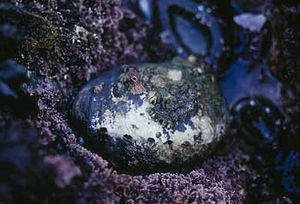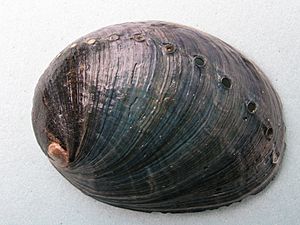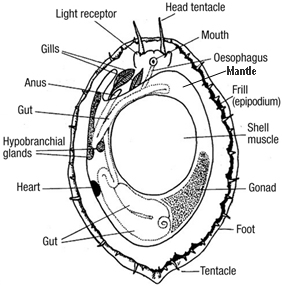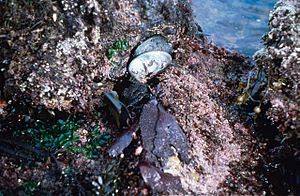Black abalone facts for kids
Quick facts for kids Black abalone |
|
|---|---|
 |
|
| Haliotis cracherodii in situ | |
| Conservation status | |
| Scientific classification | |
| Synonyms | |
|
The black abalone (scientific name: Haliotis cracherodii) is a type of large, edible sea snail. It is a marine gastropod mollusk that belongs to the abalone family, Haliotidae.
This species is smaller than most other abalones found in the eastern Pacific. It has a smooth, dark shell.
Black abalones used to be very common along the west coast of North America. However, their numbers have dropped a lot. This is mainly because of too much overfishing and a disease called Withering Syndrome. Because of this, the IUCN Red List now lists the black abalone as Critically Endangered. This means it is at a very high risk of disappearing forever.
Contents
What is a Black Abalone?
The black abalone is a fascinating sea creature. It is a type of mollusk, which means it has a soft body. Like other snails, it carries its home, a shell, on its back.
Appearance of the Black Abalone
The shell of a black abalone is usually dark brown, dark green, dark blue, or almost black. The inside of the shell is shiny and silvery. It often has pretty pink and green colors that shimmer.
The outside of the shell is quite smooth. It might have some faint spiral lines. The shell is oval-shaped and evenly curved.
Black abalones have five to seven small, open holes along the left side of their shell. These holes are important for breathing. They also help the abalone get rid of waste.
The black abalone's shell can grow up to 20 centimeters (about 8 inches) long. Most are usually between 10 and 14 centimeters (4 to 5.5 inches) long.
The living animal has black tentacles, a black mantle (the part that makes the shell), and a black foot. The foot is what it uses to move around.
Where Do Black Abalones Live?
Black abalones live along the Pacific coast of the United States. You can find them from Mendocino County, California all the way down to Cabo San Lucas, Baja California, Mexico.
Long ago, Native American people living along the Pacific coast also found black abalones. For example, the Chumash people in central California harvested them over a thousand years ago. They found them in places like the Morro Bay area.
Life and Habits of Black Abalones
Black abalones have interesting ways of living and finding food. They also have special relationships with other sea creatures.
Black Abalone Homes
Black abalones like to stick to rocky surfaces. They live in the low intertidal zone, which is the area between high and low tides. They can also be found in waters up to 6 meters (about 20 feet) deep.
You can often spot them tucked into cracks, crevices, and holes. They prefer areas where the waves are moderately strong. Young abalones stay hidden in these spots to avoid predators. Older, larger abalones might move out onto open rock surfaces.
How Black Abalones Grow
Black abalones become adults and can reproduce when they are about 3 years old. They can live for 30 years or even longer. Some scientists think they might live up to 75 years!
They usually lay their eggs in spring and early summer. Sometimes, they have a second spawning period in the fall. For successful reproduction, many abalones need to be close together.
Baby abalones, called larvae, swim freely for about 5 to 14 days. Then, they settle onto hard surfaces, usually near other abalones. They change into their adult form and grow a shell. Young abalones don't travel far from where they were born.
What Black Abalones Eat
Black abalones are herbivores, which means they only eat plants. They mostly feed on floating algae and kelp. The type of kelp they eat depends on where they live.
In southern California, they eat giant kelp (Macrocystis pyrifera) and feather boa kelp (Egregia menziesii). In central and northern California, they prefer bull kelp (Nereocystis leutkeana).
Friends and Foes in the Ocean
Besides humans, black abalones have other predators. These include sea otters, fish like the California sheephead, and invertebrates. Crabs, such as the striped shore crab, and spiny lobsters also hunt them.
Black abalones also compete for space with other sea creatures. For example, they often compete with sea urchins.
Black Abalones and Humans
People have been gathering black abalones along the California Coast for at least 10,000 years. On San Miguel Island, old evidence shows that the Chumash people ate black abalone. They also used the shells to make fishing hooks, beads, and decorations.
After European diseases affected the Native American people, and sea otters were hunted, black abalone numbers grew back. This led to a lot of fishing by Chinese immigrants from the 1850s to about 1900.
Protecting the Black Abalone
The black abalone is in serious trouble. Its numbers have fallen sharply across its natural home. In some areas, they have completely disappeared.
Why Are They Endangered?
The main reasons for their decline are:
- Overfishing: After World War II, people caught too many abalones. Fishermen would move from one abalone species to another as they ran out. Black abalones were the last ones to be heavily fished in the 1970s.
- Disease: A serious illness called withering syndrome started in 1985. This disease stops the abalone from digesting its food properly, causing it to starve. It spreads quickly and has wiped out over 90% of abalone populations in many places. The disease reached the mainland coast in 1992.
- Other Threats: Building homes and harbors along the coast, and waste pollution, also harm abalone habitats. Even though fishing is now regulated, some illegal fishing (poaching) still happens.
What is Being Done?
The International Union for the Conservation of Nature lists the black abalone as Critically Endangered. In 2009, the U.S. National Marine Fisheries Service officially listed it as an endangered species. They also set aside special "critical habitat" areas in 2011 to protect them.
The state of California has a plan called the Abalone Recovery Management Plan. This plan helps guide efforts to save the abalone. In California, all abalone fishing is now managed by the California Department of Fish and Game. They control the size of abalones that can be caught and when fishing can happen. In Mexico, there are limits on how many black abalones can be caught. These efforts are crucial to help the black abalone recover.






